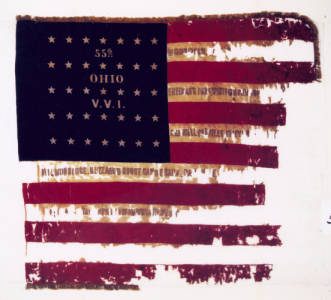Battle flags are often a source of pride, fellowship and identity for soldiers and civilians alike. They can represent the sacrifice and service performed by those who lived and died beneath the fluttering banners.

The study of flags and their symbolism is called vexillology. We can learn a great deal about a time period and a people by studying the symbols used in public, formal representations like flags. It helps to understand why and how something was used in the past and why it was important.
For example, when studying the Civil War national colors of the Ohio battle flag collection, there are three common patterns used in the canton. The canton is the blue field with stars in the upper left of the flag. Even though most of the flags have no manufacturer’s marks, there are clues that tell us where they were made. Prior to 1912, there were no regulations related to the proportion of the flag, the proportion of the canton, or the arrangement of the stars. By noticing the differences we can learn more about the flags.
There were depots or supply centers that supplied the Union armies with flags during the Civil War. Each depot had a distinctive style. National colors with a square canton and a rectilinear star pattern are indicative of a New York Depot flag. National colors with a rectangular canton and an oval star pattern are indicative of a Philadelphia Depot flag. National colors with a rectangular canton and a rectilinear star pattern are indicative of a Cincinnati Depot flag.
Symbols that have a particular meaning can change over time or be replaced by a new and different symbol to represent the same thing.
Sometimes the same symbol can represent different ideas to different people at the same time. Object collections like the Ohio battle flag collection are an excellent primary source and are rich in symbol. They provide a means of comparison that help in identifying and authenticating material culture. Their preservation both honors the past and provides meaning to the present and future.
For further reading:
Flags of the U.S.A. by David Eggenberger, New York: Thomas Y. Crowell Company
The Flag Book of the United States by Whitney Smith, New York: Morrow
The Stars and Stripes and Other American Flags by Peleg Dennis Harrison, Boston: Little Brown & Company
Cliff Eckle, History Curator